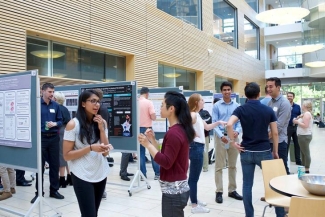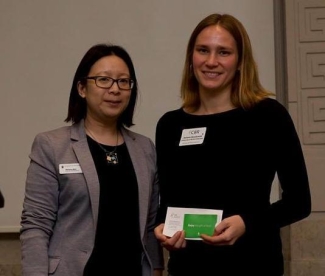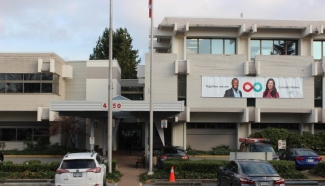From artificial intelligence to whale poop, and everything in between
Thursday, September 12, 2019 Dr. Geraldine Walsh
As Centre for Blood Research (CBR) director Dr. Edward Conway opened Research Day 2019, there was a frisson of nervous tension among the summer studentship trainees sitting in the jam-packed auditorium. These undergraduate students had spent the summer working in the laboratories of the University of British Columbia’s Centre for Blood Research (CBR) and School of Biomedical Engineering. Dr. Conway reminded them of the format for the afternoon; they would each get just 2.5 minutes to summarize their work for the audience. The squawk of a rubber chicken manned by Kevin the timekeeper would be the warning that their time was up.
And so began the rolling presentations. One after another, the students stood and presented their work on an incredibly diverse range of topics. From understanding the molecular mechanisms of breast cancer metastasis to developing microfluidic devices to analyze red blood cell deformability. From the perceived trustworthiness of artificial intelligence in medical decision-making to using social media to effectively communicate science. From 3D printing heart tissue to printing single cells using inkjet nozzles. From designing a low-cost handheld skin cancer detection device to analyzing how pumps for blood transfusions might impact the infused blood. There were thirty-five project presentations in less than two hours. But this daunting agenda delivered. Congratulations to all presenters who did a fantastic job of describing their research and keeping the audience engaged and informed.
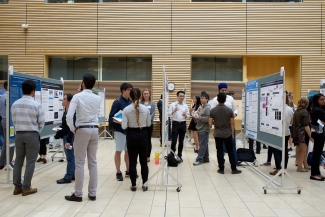
This year for the first time, the CBR Summer Studentship Program was run in partnership with the School of Biomedical Engineering (SBME), an initiative which contributed to the diversity of topics presented. This partnership is a great fit, as noted by Dr. Conway:
“We are thrilled to have had the opportunity to welcome students from the School of Biomedical Engineering into the CBR’s Summer Studentship Program. With rapid developments in technology that contribute to the progress of medicine, constant and effective communication between biomedical engineers and life scientists is essential. I’ve had loads of feedback from this year's summer students, that they enjoyed this chance to “cross-fertilize”… we hope to expand the program!”
After the student presentations, keynote speaker Dave Ireland spoke. Ireland applies his decades of experience as a researcher and teacher to advocate for nature and the conservation of biodiversity. He has worked as a senior curator of conservation and the environment at Toronto Zoo and as the managing director of the Centre for Biodiversity at the Royal Ontario Museum. An advocate of citizen science, Ireland is also the founder of the Ontario BioBlitz, a community-based wildlife survey program that encourages public participation in science. A storyteller and communicator, Ireland asks big questions about how research can effect change in the world.
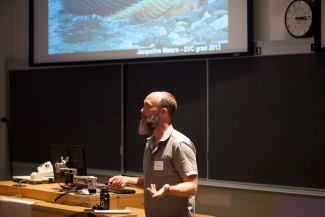
By the end of Ireland’s engaging presentation, the audience had learned how whales and their poop could save the planet. Showing some impressive images of copious whale poop, Ireland described how massive phytoplankton blooms can grow around these discharges in the ocean. Whale poop is the ocean’s fertilizer. It recycles iron, an important nutrient for phytoplankton, the tiny organisms that are a major food source in marine ecologies. Like plants, phytoplankton produce oxygen and sequester carbon – linking whales and the delicate balance of the marine ecosystem directly with our planet's ability to adapt to and mitigate climate change.
CBR Research Day is the culmination of the Summer Studentship Program, and an opportunity to recognize the hard work of the summer students and all those in the laboratories who trained and supported them. After the talks, there was a poster session during which the summer students as well as graduate students and post-doctoral fellows affiliated with the CBR were given the opportunity to present their work and chat one-on-one with attendees. Prizes were given for the best poster and oral presentations, and the annual Neil Mackenzie Mentorship Excellence Award was presented.
- Visit the Centre for Blood Research blog about Research Day 2019 to learn more about these awards and the winners.
The Centre for Innovation is proud to partner with the CBR on their Summer Studentship Program and to sponsor the CBR Research Day.
Thinking of becoming a summer student yourself?
The CBR-SMBE Summer Studentship Program provides undergraduate students with an opportunity to get hands-on lab experience. The student’s research work is guided by a principal investigator or postdoctoral fellow, and their experience is enhanced through research skills workshops, tours of campus facilities, and complementary social events.
Visit the Centre for Blood Research website for information and application details.
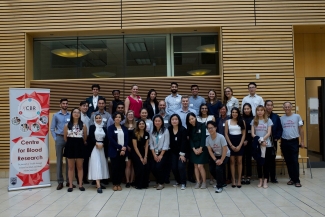
Canadian Blood Services – Driving world-class innovation
Through discovery, development and applied research, Canadian Blood Services drives world-class innovation in blood transfusion, cellular therapy and transplantation—bringing clarity and insight to an increasingly complex healthcare future. Our dedicated research team and extended network of partners engage in exploratory and applied research to create new knowledge, inform and enhance best practices, contribute to the development of new services and technologies, and build capacity through training and collaboration. Find out more about our research impact.
The opinions reflected in this post are those of the author and do not necessarily reflect the opinions of Canadian Blood Services nor do they reflect the views of Health Canada or any other funding agency.
Related blog posts
Research day celebrates the end of summer and close of the Centre for Blood Research Summer Studentship Program. This year's keynote speaker, Dr. Farah Alibay, an aerospace engineer with NASA’s Jet Propulsion Laboratory in Los Angeles spoke of her work on the Mars InSight mission.
In November, the University of British Columbia Centre for Blood Research (CBR) hosted its 12th annual Earl W. Davie Symposium in Vancouver, BC. During the event, researchers, students, clinicians and patients discussed successes and ongoing challenges in hematology, from understanding basic mechanisms of clotting to improving patient care.
By Sarah Bowers, Undergraduate Student, Brown Lab, Centre for Blood Research This post was originally published on the Centre for Blood Research blog. It has been republished here with permission with minor edits. What is involved in getting blood that has been donated at a mobile clinic in Campbell...
